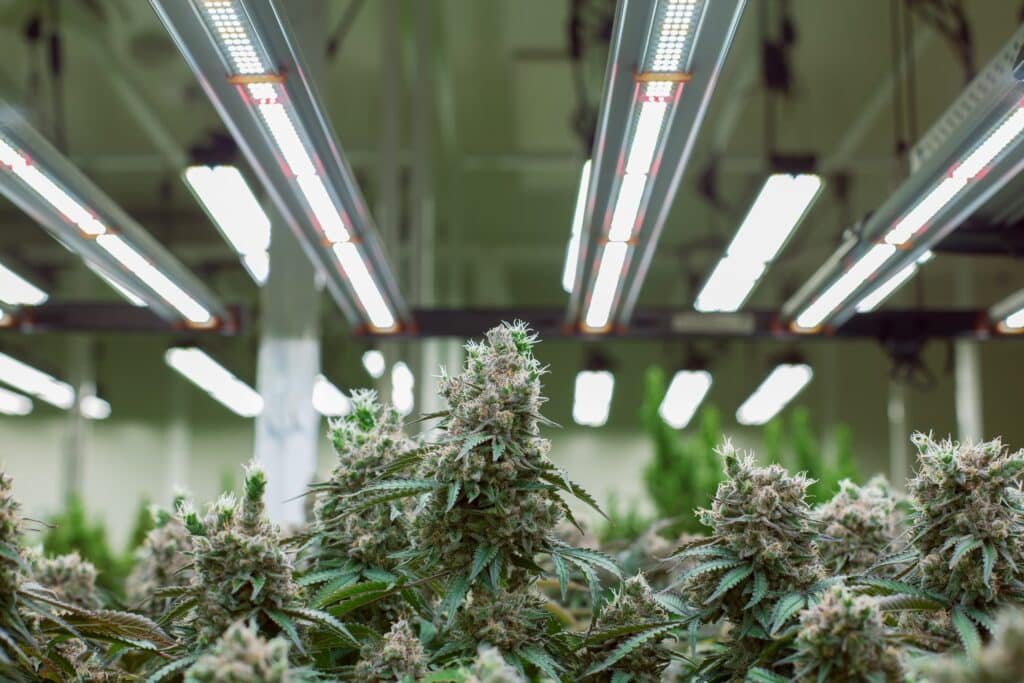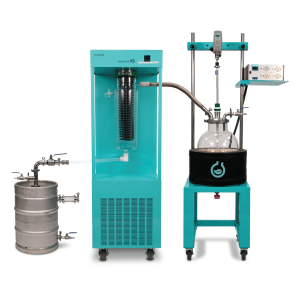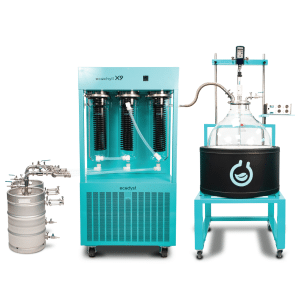Efficient Solvent Recovery & Decarboxylation Solutions for High-Quality Cannabis Products
Root Sciences offers advanced solvent recovery and decarboxylation technologies that play a critical role in optimizing cannabis and hemp extraction workflows. By streamlining solvent removal and activating cannabinoids, these systems improve overall efficiency, reduce processing time, and support regulatory compliance. Partnering with Ecodyst, our solutions help enhance the purity and potency of the final product—ensuring that extracts meet the highest quality standards for both therapeutic and commercial use.

Lab Scale

EcoChyll X1
The EcoChyll X1 is a compact, turnkey system designed for efficient solvent recovery and decarboxylation in cannabis and hemp processing. Engineered with intelligent self-cooling technology, the X1 eliminates the need for external chillers or glycol, streamlining workflows while reducing energy consumption. Ideal for small to mid-scale operations, this benchtop system enables faster evaporation rates and consistent performance for post-extraction processing.
EcoChyll X3
The EcoChyll X3 is a high-performance solvent recovery and decarboxylation system designed for scalable cannabis and hemp processing. Available in 12 L and 20 L sizes, the X3 features an energy-efficient self-cooling condenser that eliminates the need for external chillers. Its rapid evaporation capability, easy operation, and compact footprint make it ideal for labs seeking consistent throughput in post-extraction workflows.
Commercial Scale
EcoChyll X5
The EcoChyll X5 is a scalable solution for solvent recovery and decarboxylation in cannabis and hemp processing. Offered in 22 L and 50 L configurations, it supports larger batch sizes while maintaining efficient evaporation rates. With a built-in self-cooling condenser, the X5 removes the need for external chillers, helping processors streamline post-extraction workflows while reducing operational complexity.
EcoChyll X7
The EcoChyll X7 is a large-scale solvent recovery and decarboxylation system engineered for high-throughput cannabis and hemp processing. Available in 22 L, 50 L, 72 L, and 100 L capacities, the X7 accommodates a range of production volumes while maintaining consistent recovery performance. Its self-cooling condenser technology eliminates the need for external chillers, helping labs increase efficiency, reduce energy use, and simplify post-extraction operations.
Industrial Scale
EcoChyll X9
The EcoChyll X9 is designed for large-scale cannabis and hemp operations requiring efficient solvent recovery and decarboxylation. With a 200 L capacity, it supports high-throughput workflows while minimizing downtime. The X9 features a self-cooling condenser that removes the need for external chillers or glycol, streamlining operations and lowering energy use. Ideal for post-extraction processing at an industrial scale.
Solvent recovery and decarboxylation are essential post-extraction steps in cannabis and hemp processing. Solvent recovery involves reclaiming and recycling solvents used during extraction—such as ethanol or hydrocarbons—by separating them from the cannabis oil. This not only purifies the extract by removing residual solvents but also reduces operational waste and cost. Decarboxylation, on the other hand, uses controlled heat to convert acidic cannabinoids (like THCA and CBDA) into their active forms—THC and CBD—enhancing the extract’s potency and therapeutic effects. Together, these processes ensure cleaner, more effective final products and support regulatory compliance.
Solvent recovery and decarboxylation systems are key components in post-extraction cannabis and hemp processing. These technologies are used to remove residual solvents from crude oil and activate cannabinoids through heat, resulting in a purified and potent final extract. Below is a breakdown of how these systems typically function:
Step-by-Step Guide
1. Preparation
After extraction, cannabis oil contains a mixture of cannabinoids, terpenes, plant materials, and residual solvents such as ethanol or butane. The oil is collected in a processing vessel, where it is prepped for post-processing by filtering out solids and adjusting the volume or solvent content as needed.
2. Solvent Recovery Process
During solvent recovery, the cannabis oil is heated under vacuum conditions to separate and reclaim the solvent. The solvent evaporates at a lower temperature under vacuum, travels through a condenser, and is collected for reuse. This step is critical for purifying the extract, reducing residual solvent content, and minimizing waste.
3. Decarboxylation Process
Once the solvent is removed, the oil is gently heated to initiate decarboxylation. This process converts inactive cannabinoid acids like THCA and CBDA into their active forms—THC and CBD—by releasing carbon dioxide (CO₂). Proper decarboxylation enhances potency, bioavailability, and consistency in the final product.
4. End Product
The result is a clean, solvent-free, and fully decarboxylated cannabis oil that is ready for further refinement, formulation, or product development. This step is essential for producing high-quality cannabis extracts that meet safety and potency standards.
Production Scale
Choosing a system that aligns with your production volume is essential for maintaining workflow efficiency. Smaller labs may benefit from benchtop units with lower throughput, while larger facilities require high-capacity systems capable of continuous operation. Matching system size to your extraction scale helps avoid bottlenecks and improves overall process performance.
Solvent Types
Different extraction methods use various solvents such as ethanol, methanol, or hydrocarbons. It’s important to select a recovery system designed to handle the specific solvent(s) used in your operation. Systems compatible with multiple solvent types provide greater flexibility, especially for facilities using hybrid extraction techniques.
Decarboxylation Temperature and Time Control
Accurate control over decarboxylation parameters is key to consistent cannabinoid activation. Look for systems with programmable settings that allow you to fine-tune temperature and exposure time. This ensures effective conversion of acidic cannabinoids like THCA and CBDA into THC and CBD without degrading the extract.
Automation Features
Modern systems often include automation to streamline workflows and reduce operator error. Features like automated solvent removal, decarboxylation cycles, and digital monitoring help maintain consistency, improve safety, and minimize labor demands—ideal for facilities focused on scaling production.
Compliance & Certifications
To meet regulatory requirements, choose equipment that adheres to safety and quality standards such as cGMP, CE, or UL certifications. Closed-loop designs, accurate data logging, and material traceability support both internal QA programs and external inspections.
Energy Efficiency
Energy-efficient systems help reduce operational costs and environmental impact. Self-cooling condensers, vacuum-assisted evaporation, and low-temperature decarboxylation options are all features that can contribute to energy savings without compromising performance.
Budget & ROI
When selecting a system, consider both upfront cost and long-term return on investment. While advanced models may carry a higher initial price, their efficiency, solvent savings, and labor reduction often result in lower total operating costs—making them a smarter choice for long-term profitability.
Maximized Solvent Recovery
Solvent recovery systems are designed to reclaim the majority of solvents used during extraction, often achieving recovery rates above 95%. This reduces the need for constant solvent replenishment, lowers hazardous waste output, and supports sustainable cannabis and hemp processing practices.
Consistent Decarboxylation
Automated decarboxylation systems provide precise control over temperature and time, ensuring cannabinoids like THC and CBD are consistently activated. This consistency enhances potency, bioavailability, and product performance—especially important for medicinal and edible applications where dosing accuracy matters.
Improved Product Quality
By efficiently removing residual solvents and fully activating cannabinoids, these systems help produce cleaner, more potent extracts. The result is a high-quality end product with improved purity, better flavor, and greater therapeutic value, aligning with both consumer expectations and industry standards.
Increased Efficiency
Integrating solvent recovery and decarboxylation into post-extraction workflows streamlines operations by reducing manual handling and processing time. With faster turnaround and reduced labor demands, processors can increase throughput while maintaining quality control across each batch.
Regulatory Compliance
Properly engineered systems support compliance with safety and quality regulations by minimizing solvent exposure and ensuring traceable, controlled processing. Closed-loop recovery, accurate temperature monitoring, and documentation features help meet cGMP, OSHA, and other local or national regulatory requirements.
Cost-Effective Solutions
Over time, solvent recovery and decarboxylation systems contribute to significant cost savings. Reusing solvents, minimizing product loss, and reducing labor hours all translate into lower operational expenses—making these systems a practical investment for processors seeking scalable, long-term growth.
1. What solvents can your recovery system handle?
Our solvent recovery systems are designed to handle a wide range of commonly used extraction solvents, including ethanol, methanol, isopropanol, and hydrocarbons like butane and propane. These systems effectively separate and reclaim solvents from cannabis extracts, supporting clean processing and sustainable lab operations.
2. How does solvent recovery improve efficiency in the extraction process?
Solvent recovery reduces both waste and operational costs by recycling extraction solvents for reuse. By reclaiming solvents directly after extraction, processors can minimize downtime, lower solvent purchases, and speed up post-processing—resulting in a more efficient and cost-effective extraction workflow.
3. What is decarboxylation, and why is it important for cannabis products?
Decarboxylation is the process of heating cannabis oil to convert acidic cannabinoids (like THCA and CBDA) into their active forms (THC and CBD). This activation step is essential for achieving the desired potency and therapeutic effects in cannabis products, especially those intended for inhalation or oral consumption.
4. Can I customize the decarboxylation process for different cannabinoids?
Yes, many decarboxylation systems allow you to adjust temperature and duration settings to suit different cannabinoid profiles. This flexibility is especially useful when working with minor cannabinoids or when targeting specific formulations, as each compound may decarboxylate at slightly different rates.
5. What are the recovery rates for solvents in your system?
Our solvent recovery systems are engineered for high efficiency, with recovery rates typically exceeding 95%. Actual performance may vary depending on solvent type, input volume, and operating conditions, but most processors can expect consistent recovery results that support sustainable and cost-effective extraction.
6. How can I ensure regulatory compliance in solvent recovery and decarboxylation?
To maintain compliance, it’s important to use closed-loop systems that minimize solvent exposure and meet industry safety standards. Accurate temperature control, validated operating procedures, and proper documentation of batch processes also help meet local and national regulations for cannabis and hemp processing.
7. What is the ideal temperature and time for decarboxylation in your systems?
While exact parameters may vary based on the system and cannabinoid profile, decarboxylation typically occurs between 220°F and 250° F (104° C to 121° C) over 30 to 90 minutes. Our equipment provides precise control over both temperature and duration to ensure consistent cannabinoid activation while avoiding degradation.
8. Can solvent recovery and decarboxylation systems be integrated into existing extraction setups?
Yes, most solvent recovery and decarboxylation systems are designed to integrate seamlessly with existing extraction workflows. Whether you operate an ethanol, hydrocarbon, or CO₂-based system, these units can be installed as standalone modules or incorporated into a continuous processing line to enhance throughput and efficiency.




